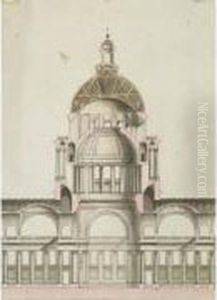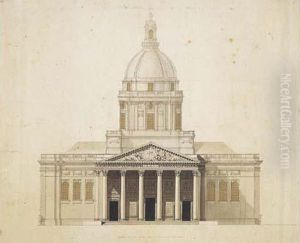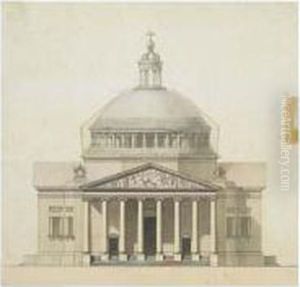Jacques Germain Soufflot Paintings
Jacques Germain Soufflot was a prominent French architect, born on July 22, 1713, in Irancy, near Auxerre, in the Burgundy region of France. His work is often associated with the genesis of Neoclassicism, a movement that sought to revive and emulate the principles and aesthetics of classical antiquity. Soufflot's architectural designs played a significant role in the transition from the Baroque to the Neoclassical style in France, influencing the direction of French architecture towards greater simplicity and structural clarity.
Educated at the Collège de Navarre in Paris, Soufflot embarked on a Grand Tour of Italy at the age of 20, which was customary for young men of his social and economic standing. His time in Italy, especially in Rome, profoundly influenced his architectural outlook, immersing him in the study of ancient Roman architecture and the Renaissance works of architects like Michelangelo and Palladio. This experience instilled in Soufflot a lifelong passion for classical simplicity and harmony, which would later become hallmarks of his work.
Soufflot's most famous work is the Panthéon in Paris, originally designed as the Church of Sainte-Geneviève. Commissioned in 1755 by King Louis XV, the Panthéon was intended to be a grandiose church dedicated to the patron saint of Paris. Soufflot's ambition was to combine the structural lightness and brightness of a Gothic cathedral with classical architectural principles. His innovative use of a Greek cross layout and the employment of a dome supported by light, slender columns reflected a departure from the heavier, more ornate Baroque style dominant at the time. The Panthéon's completion, however, was marred by delays and modifications, and Soufflot did not live to see it finished in its intended form; he died on August 29, 1780, in Paris.
Soufflot's contributions to architecture extend beyond the Panthéon. He was instrumental in introducing neoclassical architecture to France, influencing a generation of French architects. His emphasis on purity of form, structural clarity, and the integration of new engineering techniques with classical aesthetics marked a significant turning point in French architecture. Despite facing criticism from contemporaries who questioned the structural soundness of his designs, Soufflot's legacy endures, particularly in the Panthéon, which stands as a monument to his visionary blend of architectural innovation and reverence for classical traditions.


